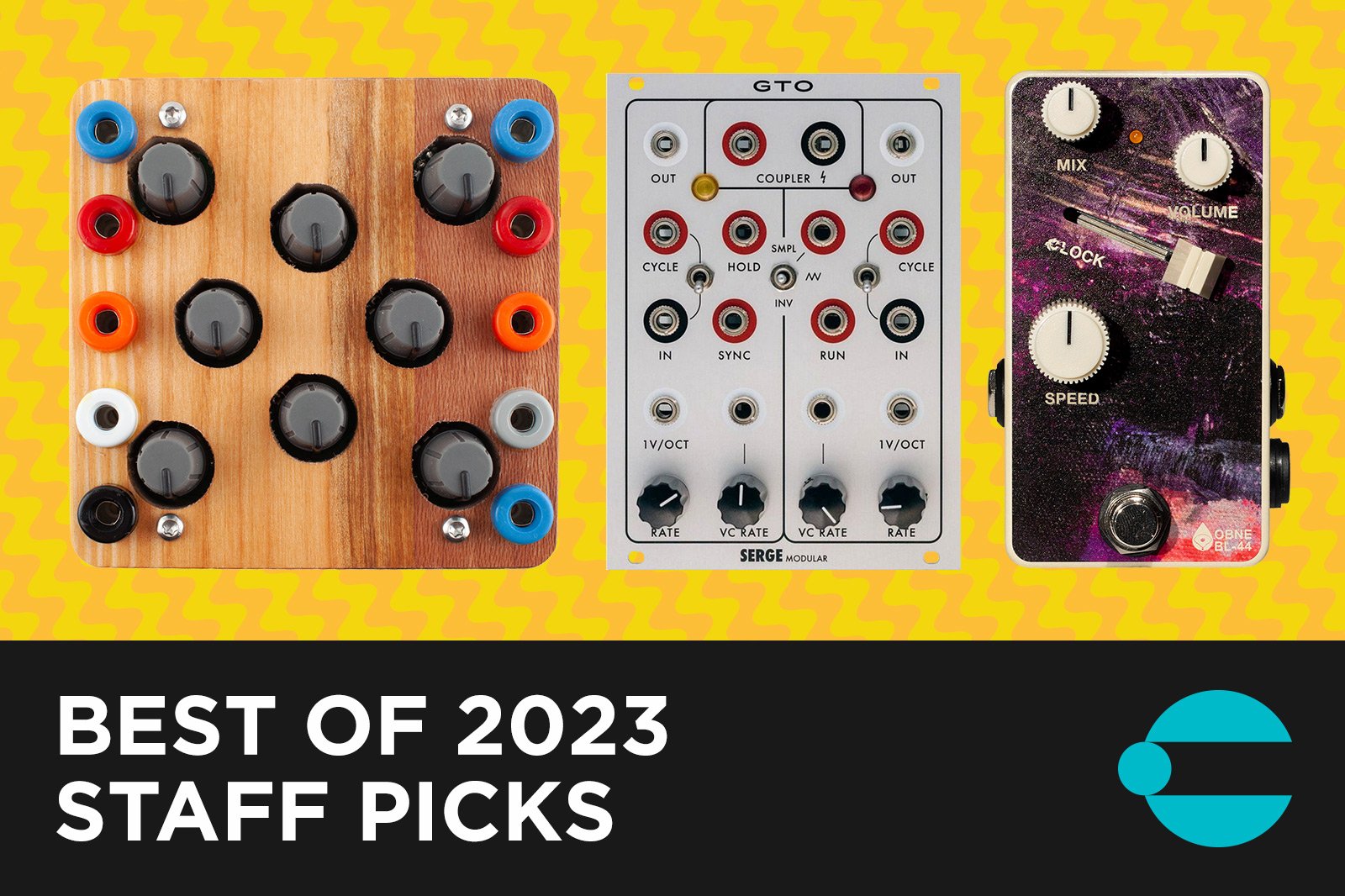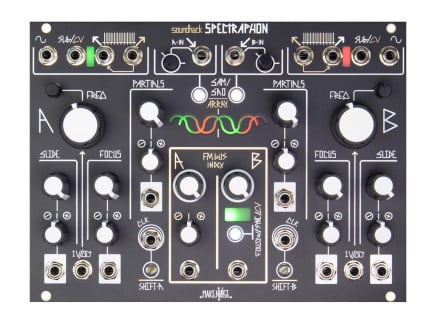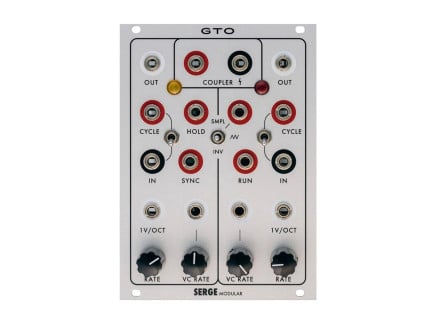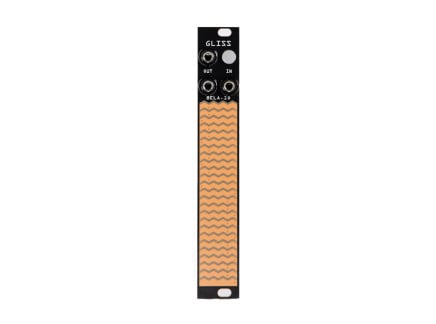It's that special time of year when before we begin to look ahead at what's to come, we reflect upon the past several months and reminisce on all we've seen and experienced this year. Of course, that includes all of the spectacular electronic music gear that has come out this year, and between all of the slick new Eurorack modules, pedals, synthesizers, and drum machines that have come into our lives in 2023... there's always so many things to choose from!
Alongside this article, we've been asking some friends, artists, and content creators what their gear of the year picks are, and now we—the staff of Perfect Circuit—are here to share the things that have stuck out to us the most. Obviously, this is but a mere handful of the super cool instruments and devices that were released in 2023, but we felt that these deserved some special attention in our year-end wrap-up.
So without further ado, let's get into the Perfect Circuit Staff Picks of 2023.
Make Noise Spectraphon
The soundhack Spectraphon is one of Make Noise's most ambitious modules to date. It combines influences from many niche corners from the history of modular synthesis and computer music—making reference to the vanishingly rare Buchla Touché, 296 Programmable Spectral Processor, 259 Programmable Complex Waveform Generator, and the notoriously complex process of additive resynthesis. If that seems like a mouthful, here's the simple pitch: Spectraphon is a dual oscillator whose timbres are derived from external sound sources.
Spectraphon is laid out somewhat similarly to a typical "complex oscillator": it's arranged as two oscillators with a central FM bus, which allows each oscillator to modulate one another's frequency. It features several parameters that offer continuous control of timbre—and, with some subtle exceptions, both oscillators are identical to one another. Ultimately, you can treat it like two completely separate sound sources...or alternatively, you can use inter-oscillator modulation to create some truly mind-blowing, high-resolution, heavily-modulated tones.
So, you can use Spectraphon like any other complex oscillator. But what makes it particularly special is that its timbre controls are derived in part from external sound sources. So...how does that work? Understanding Spectraphon requires a description of its two primary modes of operation: Spectral Amplitude Modulation (SAM) and Spectral Array Oscillation (SAO). In SAM mode, Spectraphon "listens" to audio at its input, and uses the Slide and Focus controls to map the incoming sound's overtone structure onto its internal synthesis engine. Using the Partials control, you can vary the overall brightness of the sound by gradually introducing higher overtones. This is somewhat like a peculiar vocoder—using one sound to determine the overtone structure of the oscillator itself.
In SAO mode, you can store "Arrays" of data from external sound sources—effectively capturing "snapshots" of an incoming sound's spectral structure over time. Once stored, the Slide and Focus controls allow you to scan through the selected Array—producing a form of resynthesis by using the stored data to determine the oscillator's overtone structure. By modulating the Slide and Focus controls, you can get everything from slowly evolving tones to jarring, stuttering transitions. Of course, the nature of the oscillator's tone will depend entirely on the audio that you had recorded into it—and given that the external inputs offer enough gain to connect external sound sources, you could use nearly anything to "drive" Spectraphon.
This is just scratching the surface. Each oscillator can operate in either SAM or SAO mode at any given time; it features additional programmable modulation outputs; it features interesting ways of dividing the odd and even partials of a sound between separate outputs; and so much more. If you want learn more, I'd strongly recommend checking out our dedicated article, Infinite Textures: Make Noise Soundhack Spectraphon, which gets much deeper into Spectraphon's capabilities and inspiration.
Random*Source Serge Modular GTO
As fans of deeply patching modular synthesizers, many of us here at Perfect Circuit hold a strong affinity for the circuits and sounds of Serge systems. Their open-ended nature, often called patch-programmability, was codified into designs like the Dual Universal Slope Generator and Smooth & Stepped Generator—both are highly flexible circuits that can serve different purposes depending on how they're patched. The SSG, in particular, perhaps embodies this philosophy more than any other: it can be an LFO, a sample-and-hold, a pseudo-lowpass gate, and more. Earlier this year, Random*Source unveiled the GTO: a descendent of the SSG and the latest entry in a strong lineage of patch-programmable Serge designs.
The release of the GTO is pretty significant—it's really the first new design from Serge Tcherepnin himself since the 1980s, who joined Random*Source as Chief Innovation Officer back in 2018. Until now we've seen tweaks and refinements to classic Serge designs throughout Random*Source's Serge Eurorack offerings, along with modern appointments added to their recent Paperface 50th Anniversary systems. So although the GTO bears a strong resemblance to the SSG and certainly offers some functional overlap, the internal changes to the circuit required for the new features are so significant that it really shouldn't be considered the same module.
Compared to the SSG, the GTO excels at audio-rate applications: tighter cycling times and 1V/Oct inputs encourage you to patch it up as something of a Serge-style spin on a complex oscillator. What was formerly the "Stepped" channel features a new mode switch plus a Run input that can lead to some new behaviors and patches that could not be achieved on the original SSG, such as bitcrusher-like effects and dual Smooth oscillators at high audio frequencies. Add in the Smooth channel's new Sync input and the classic Coupler comparator section, and there's an abundance of new patches to be discovered inside the GTO.
We could go on and on about ways to use the GTO, but we have other gear that needs to be covered! If you want to dive deeper into the GTO, check out the dedicated article we wrote for its release earlier this year.
Old Blood Noise Endeavors BL-44 Reverse Pedal
Coming out just as we wrapped up our Staff Picks selections last year, Old Blood Noise's BL-44 Variable-Clock Reverse pedal has been on our minds ever since—so it only makes sense to be on our list this year. Ever since we got our hands on the BL-44, we've had non-stop fun flipping and reversing anything and everything that we''ve run into it. But not only is it a stellar reverse delay effect, it also established a new line of performable effects pedals that greatly encourage hands-on exploration.
Central to the BL-44's operation is the ability to directly control its DSP clock rate, which in turn affects the length and quality of the reverse delays. Effects pedal fans may recall that Old Blood contributed a set of delay and reverb effects to the original Chase Bliss Mood, which also featured a quantized clock control for its internal DSP chip. While the BL-44 is more specifically focused on reverse delay, it still follows in this spirit of the Mood with its own twists on the idea of controlled-clock effects processing.
With previous products like their Expression Slider, Old Blood Noise Endeavors has long championed the idea of getting your hands dirty with your effects pedals. And with more synthesists and other users of tabletop effects turning to pedals, it only makes sense to keep exploring that space. In that vein, the BL-44 puts its Clock control on a diagonal slider, smoothly ranging from crisp and clean high-speed reverse delays to gritty, grungy, and degraded repeats. The accompanying Speed control applies quantized shifts in delay time, offering abrupt shifts in pitch and rhythm that may then be manually stretched with the Clock slider.
The BL-44 was something of a smash hit for OBNE—such that even they themselves have admitted being pleasantly surprised by its success. With this in mind, we've already seen some more additions to the BL family of clock-controlled DSP effects: the BL-37 reverb and the BL-82 chorus. We're sure that there's still even more to come from Old Blood.
Ciat-Lonbarde Peterlin
Some love synthesizers for their precision and reliability in reproducing sounds exactly as expected. Others, including myself, are attracted to the unpredictable, capricious, and mutable characters that some species of synthesizers possess. If encounters with mercurial sonic worlds are just as appealing to you, then perhaps there is no place quite like the world of Ciat-Lonbarde. Enclosed in distinctive wooden panels, the instruments designed by Peter Blasser often feel more than musical devices, but rather as sonic organisms that respond to your gestures and improvise with you. Full of personality, they can never be entirely tamed, yet they are not uncontrollable. Instead, they exist on a spectrum between acquiescence and wildness.
The Peterlin, with its familiar banana jack-adorned wooden aesthetics, proudly represents Ciat-Lonbarde's homage to the legendary synth creator, Rob Hordijk. As the name suggests, it is Peter's take on the widely revered Benjolin. More than merely a synth, it is a foray into a world where the familiar meets the esoteric, a realm ruled by oscillating chaos and melodious order. Originally designed by Hordijk as a gift for the DIY community, Benjolin is a coalescence of a couple of oscillators, a resonant low-pass filter, and an ingenious Rungler circuit that accepts the signals from each oscillator and feeds back into itself and the second oscillator unleashing a spectrum of sounds ranging from deep, resonant drones to erratic acoustic phenomena.
With Peterlin, Blasser maintained the authenticity of the original concept, while fully redesigning and streamlining the circuit, resulting in an amazingly portable, battery-powered instrument with the same unruly demeanor the classic Benjolin is known and loved for. The four primary knobs flanking the panel's corners are foundational controls over the frequency of each VCO, and filter frequency cutoff and resonance. Accompanying CV inputs are strategically placed to infuse Peterlin with external vitality or to further interconnect its internals. The central control zone, with its quartet of knobs, stands as the cockpit from where one pilots the Rungler back into the oscillators, and filters. Because Peterlin is a chaotic system, even minor shifts between the controls can yield dramatic changes that can range anywhere from sporadic percussive pulsations to textured drones to melodic sequences. The convention constraints of electronic instruments don't apply here, as Peterlin thrives on the brink of total auditory pandemonium.
Ciat-Lonbarde's Peterlin stands tall in the pantheon of modern synthesizers. Its versatility in producing sounds ranging from tranquil, harmonic tones to the most extreme forms of sonic chaos marks it as a vital instrument for any adventurous sound designer. The thoughtful design that lends the instrument to intuitive interaction, as well as an absolute cornucopia of sonic capabilities, renders the Peterlin my personal pick of the year. This instrument is not only an excellent introduction to the unique world of Ciat-Lonbarde and chaotic synthesis, but its extensive potential also makes it an ideal choice for synthesists at any stage of their musical exploration.
Bela Gliss
Gliss from Bela is a compact touch controller module that couples an extreme amount of flexibility with an intuitive interface. One of the greatest things about this particular touch controller is the inclusion of two faceplates: one for holes-on-top and one for holes-on-bottom so no matter where you place your Gliss in your system, it will feel comfortable. Not satisfied with just a couple of modes, Bela has added four to the Gliss giving you simple touch, recorded gestures, and discrete voltages.
The hardware used on the Gliss is superb and offers high resolution for movement and pressure, both of which have customizable sensitivities. The voltage range can be adjusted from 0 to +10v, 0 to +5v, -5v to +5v, and -5v to +10v, or you can set your own voltage range. Two CV outputs give you separate voltages for position and pressure, an input allows you to combine external signals, monitor voltages, or trigger recorded motion, and a button is included for manually triggering voltage shapes and accessing the menu.
Hardware aside, the modes are really what makes Gliss special: first is a basic touch voltage control mode with position and pressure output, but this can also be configured as two controllers splitting the touch bar in twain. The second mode is for recording motion that can store up to a minute of gestural undulation and can also be set up as either one or two strips. Mode three gives you the option of manipulating incoming voltages—scaling, clipping, even envelope detecting—or simply visualize them on the LED touch strip. Mode four gives you a simple 5 stage sequencer, keyboard, or stored voltage selector.
Gliss from Bela is a necessity for just about any Eurorack system and at 4hp, having multiple is not out of the question.
A Full Year of Gear
There was tons of electronic music gear released this year that we absolutely loved, so this article only represents a small selection of our absolute favorites. But even beyond what we've mentioned here, there was no shortage cutting-edge Eurorack modules, immersive effects pedals, and stupendous synthesizers that graced our ears with phenomenal sounds.
Wanna check out some more Gear of the Year picks? Check out our Artist Picks: Best Gear of the Year 2023 to see what some of our favorte artists and content creators were using this year. Otherwise, we're all eagerly awaiting what's to come in 2024!













